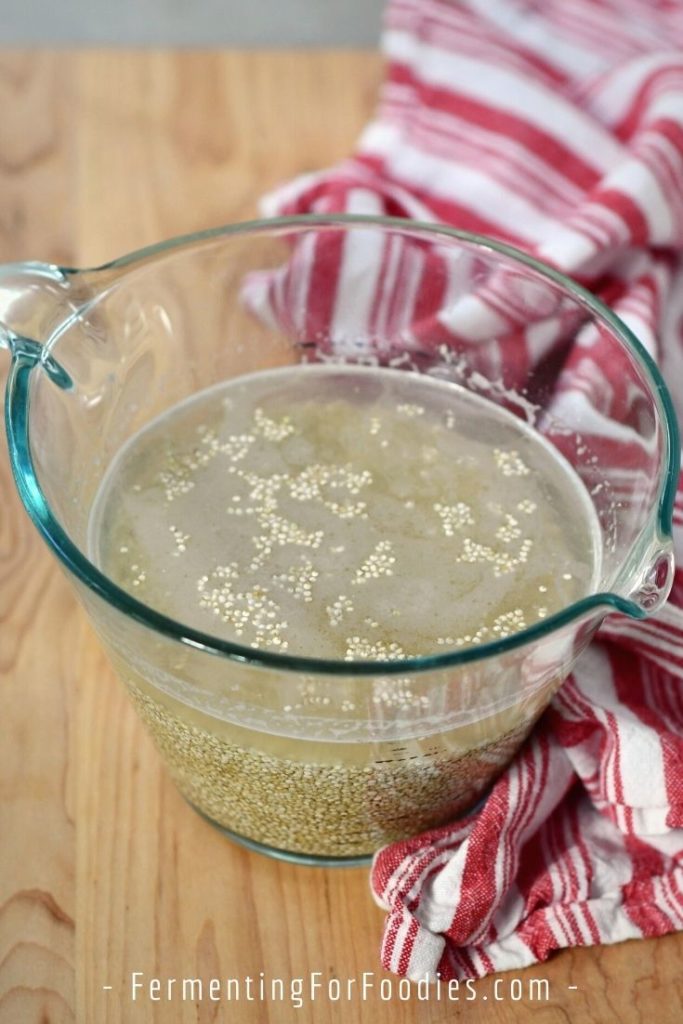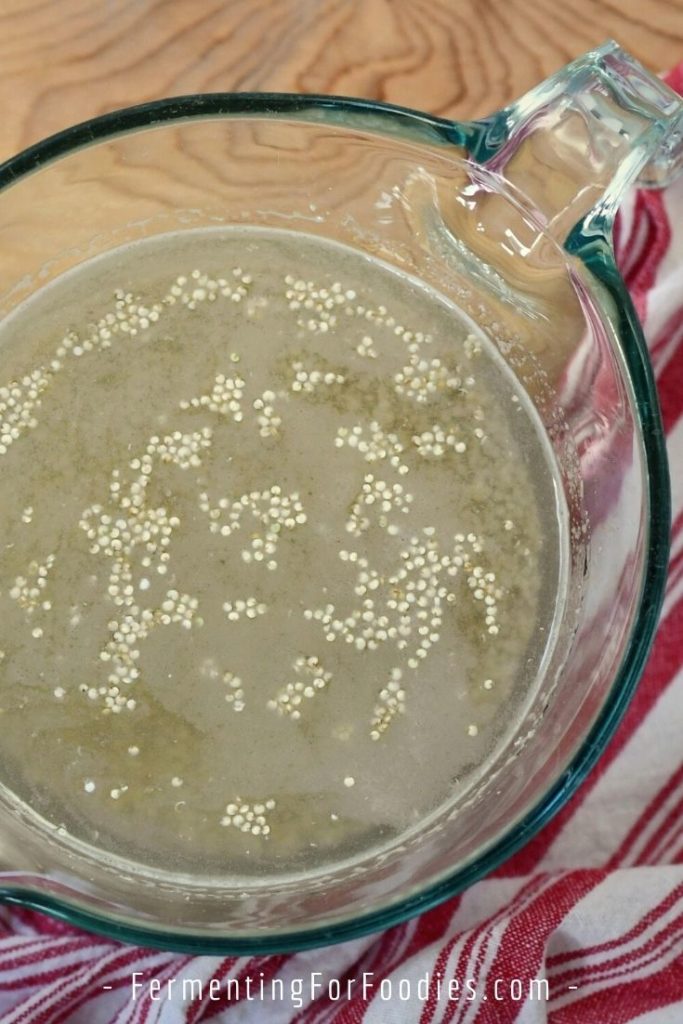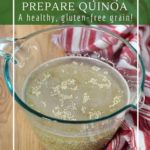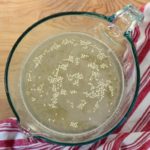Wondering about the best way to prepare quinoa? Tired of the bitter taste? Here’s why you should soak quinoa before cooking.

Quinoa is a high protein and high fiber seed that is delicious as a breakfast cereal or in the place of rice for a pilaf. However, my favorite way to eat quinoa is as a base for a hearty Mediterranean salad. Here is everything you need to know about how to properly prepare quinoa.
Why You Should Soak Seeds, Nuts, Grains and Quinoa
I recommend soaking quinoa for at least a few hours before cooking.
Most grains, legumes, nuts, and seeds benefit from pre-soaking and/or sprouting. Soaking and sprouting is a great way to improve the nutritional value of seeds nuts and grains.
Here are some of the benefits of soaking and sprouting before cooking:
- Soaking grains activates the natural enzymes making them easier to digest.
- Sprouting decreases the starchy carbohydrates and antinutrients.
- Ultimately, the nutrient value of seeds and grains is increased, because the protein, vitamins, and minerals are more easily absorbed.
Even if you aren’t convinced that you ought to be soaking and sprouting all of your grains, you soak quinoa because of the saponins.
What are Saponins?
Saponins are a compound that is found in a number of plants, particularly soapberries and soap nuts. They naturally suds up when mixed with water, for an environmentally friendly and natural soap.
However, saponins aren’t particularly good to eat. And it turns out that quinoa is particularly high in saponins. This can make quinoa particularly hard to digest and give it a bitter flavor.
Commercial quinoa is often pre-washed to remove the bitter layer before being sold. However, that doesn’t completely eliminate the saponins, so soaking quinoa prior to cooking is still a good idea.

How to Soak and Cook Quinoa
It is important to soak quinoa prior to cooking. Soaking removes the bitter-tasting saponins. It also helps to activate enzymes makes it more nutritious and easily digested. See the section above for details.
- Prep Time: 10 minutes
- Cook Time: 15 minutes
- Total Time: 25 minutes
- Yield: 2 cups 1x
- Category: Sides
- Method: Soaked
- Cuisine: Gluten Free
- Diet: Vegan
Ingredients
For Soaking
- 1 cup quinoa
- 1 1/2 cups filtered water
- 2 Tbsp of acidic culture (optional, see notes)
For Cooking
- 2 cups of water
Instructions
- Place quinoa in a large glass bowl or measuring cup. Stir in the filtered water and culture.
- Cover the container with a tea towel and leave it out on the counter to soak for at least 8 hours or up to 2 days. Longer is better if your quinoa is very bitter.
- When you are ready to cook, pour the quinoa into a fine-mesh sieve. Pour away the soaking liquid and rinse the quinoa until the water runs clear. This will remove the bitter saponins.
- Put the quinoa into a pot with 2 cups of water. Bring to a boil and simmer for 12-15 minutes (until cooked).
- Drain any excess liquid. Rinse with cool water to prevent the quinoa from overcooking. Fluff with a fork and serve immediately.
Notes
- Using a culture isn’t required for soaking quinoa, but it can help to speed things up. I recommend using something acidic like cider vinegar or sour kombucha.
- I usually cook quinoa in a rice cooker. It’s easier than keeping track of a simmering pot on the stove.
- If you want to try fermenting quinoa, then I recommend fermenting cooked quinoa. It’s a great way to get more probiotics into your diet! Try making a probiotic quinoa pudding.



Hi, thank you for the instructions. I have a question about soaking the quinoa, because I’ve read in many other places, investigating this topic, that we should avoid soaking it as saponins can leach into the seeds, that the only recommedantion is to rinse it but not soaking it.
So if soaking has a lot of benefitsfor for sprouting how does it affect this issue of saponins in te water all the night?
Thanks ahead
I haven’t heard of saponins going back into the quinoa from the soaking water. Quinoa is quite a firm grain, and soaking doesn’t cause them to soften quite the way it does with beans. In fact, I tried soaking quinoa in an acidic fermenting culture for several days and it didn’t seem to penetrate the seed at all. So my inclination is that the saponins wouldn’t soak into the quinoa.
Regardless, quinoa needs to soak in order to sprout. Hope that helps!
Hello,
The post above mentioned this and I found a source, this is on Dr. Weil’s website:
“ Avoid soaking quinoa, however, as saponins can leach into the seeds.) After rinsing, place quinoa and water in a covered pot and bring to a boil. Reduce heat and simmer for about 15 minutes, until the grains become translucent and the germ appears as a thin white ring around each grain.”
Lynn
Thanks for sharing! I had to remove the link as it was flagged by my anti-spam software. I just googled the idea that saponins would leach back into the quinoa and could only find that information on Dr. Weil’s site. However, from personal experience, I have found soaking (and sprouting) to be an effective way to reduce the bitterness of saponins.
Cheers!
It seems that the logical step would be to rinse as weil says but instead of boiling first soak and then boil.
Hi, thanks for the clear instructions. Do you have any sources for the claims in this article?
I can’t find any scientific papers proving that soaking will make quinoa better to digest.
The research into whether saponins help or hinder digestion is spotty. Regardless, saponins are very bitter. Not all brands of quinoa are high in saponins as some have been well washed or polished. It just takes one mouthful to find out if you bought well-cleaned quinoa as the bitter flavour is dramatic.
Here is some more info about saponins: https://www.intechopen.com/books/application-and-characterization-of-surfactants/saponin-based-biological-active-surfactants-from-plants
Cheers!
I want to start doing this but I cant find anywhere how much fermented liquid to add…1 tablespoon or more??
Thanks the rest of your site was very clear
Thanks Lydia! The fermentation liquid is optional because simply soaking quinoa is beneficial. However, feel free to add 2 tbsp of culture. Cheers, Emillie
This works! The quinoa was fabulous; no bitterness at all!
I had to pour/strain off 1 cup of the cooking liquid at the end.
The pre-soaked quinoa just wouldn’t absorb it. Did this happen to anyone else?
Thanks for letting me know! I’ll test the recipe again with white quinoa as it might absorb the soaking liquid better than red quinoa.
You say you prefer to use a rice cooker, but then don’t include separate directions for using one. How does it change the cooking directions, as opposed to stovetop?
Great question! I recommend following the instructions on your rice cooker for any specifications. I simply put the quinoa and water into my rice cooker (using the same measurements), push the on button, and let the rice cooker do its thing. However, I’m not sure if all rice cookers operate the same way. Cheers!
I tried the rice setting on the Instant Pot with two cups of water to one cup of soaked white quinoa.
When it was done cooking I did a quick release. Then I scooped the cooked quinoa into a fine-mesh sieve, rinsed it again with cold water to stop it from cooking further and got mushy, not fluffy quinoa.
Perhaps it only needs 1 1/2 cups of water.
An instant pot will definitely require less water. 🙂 It holds in all the steam unlike cooking on the stove or in a rice cooker. Cheers!
How is the rice cooker function on an Instant Pot different from an actual rice cooker? Jeff asked about the proportions for a rice cooker and was instructed to use the same ones as your original recipe. What a waste of time and ingredients this was. What do I do with all of this mushy quinoa 🙁
Instant pots hold in pressure so none of the added water will escape as steam. Most rice cookers are the same as a pot boiling on the stove. The steam will escape around the sides of the lid. Can you add the quinoa to a soup? Or turn it into a risotto-like dish? Cheers!
Thank you for this information. I linked to your site just to find information on how long it is ok to soak the quinoa and still safe to cook and eat. I’m of the same thought as you on soaking. I’ve been using the soak method for quinoa for years and am happier with the flavor.
Nice! Thanks for reaching out. Be well, Emillie
What is considered an acidic culture? Thanks!
Vinegar or kombucha both work. I don’t recommend lemon juice or anything like that because you don’t want it to go off while soaking. Cheers!
Hi there, I came to your site looking for tips to resolve a quinoa challenge I’m having. When I soak as suggested all over the internet, overnight, the quinoa turns to a mush when cooking as normal. There is no cooking out all the water, it’s just a glue like mush. I can’t find anyone discussing this but I am unable to eat quinoa anymore until I solve this puzzle as I don’t like quinoa mush. Any suggestions would be appreciated : )
Hi Lisa,
Quinoa is really easy to overcook (or cook until mushy). Try shortening your cooking time, which should prevent it from going mushy. Then either serve it right away, or drain and rinse with cold water (to stop it from continuing to cook). Hopefully, these suggestions help!
Cheers, Emillie